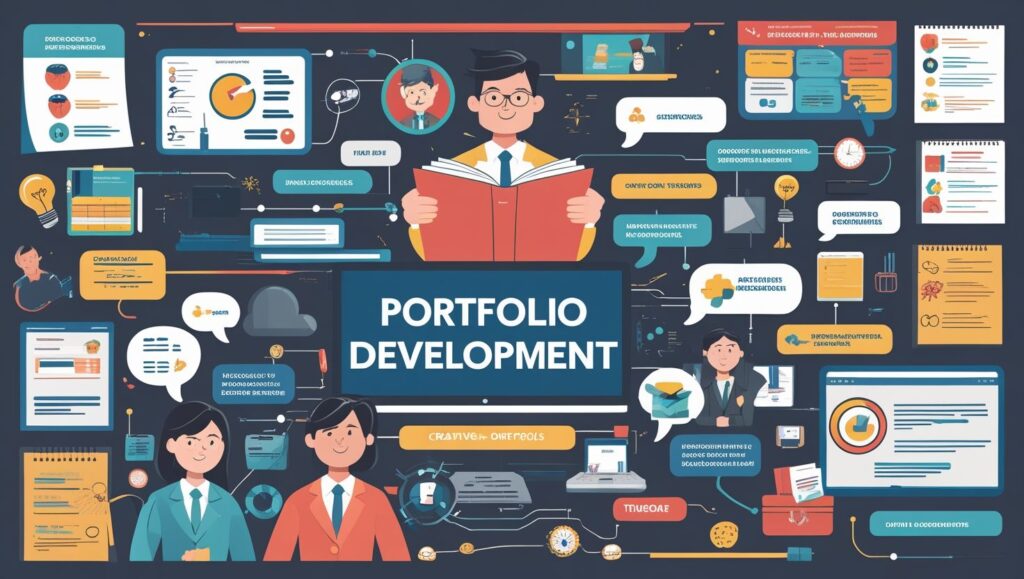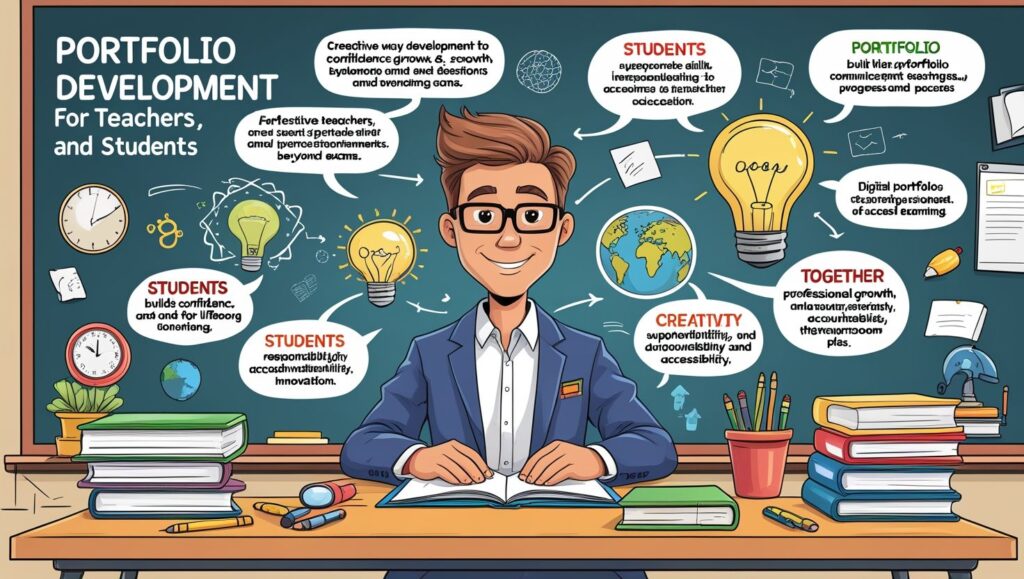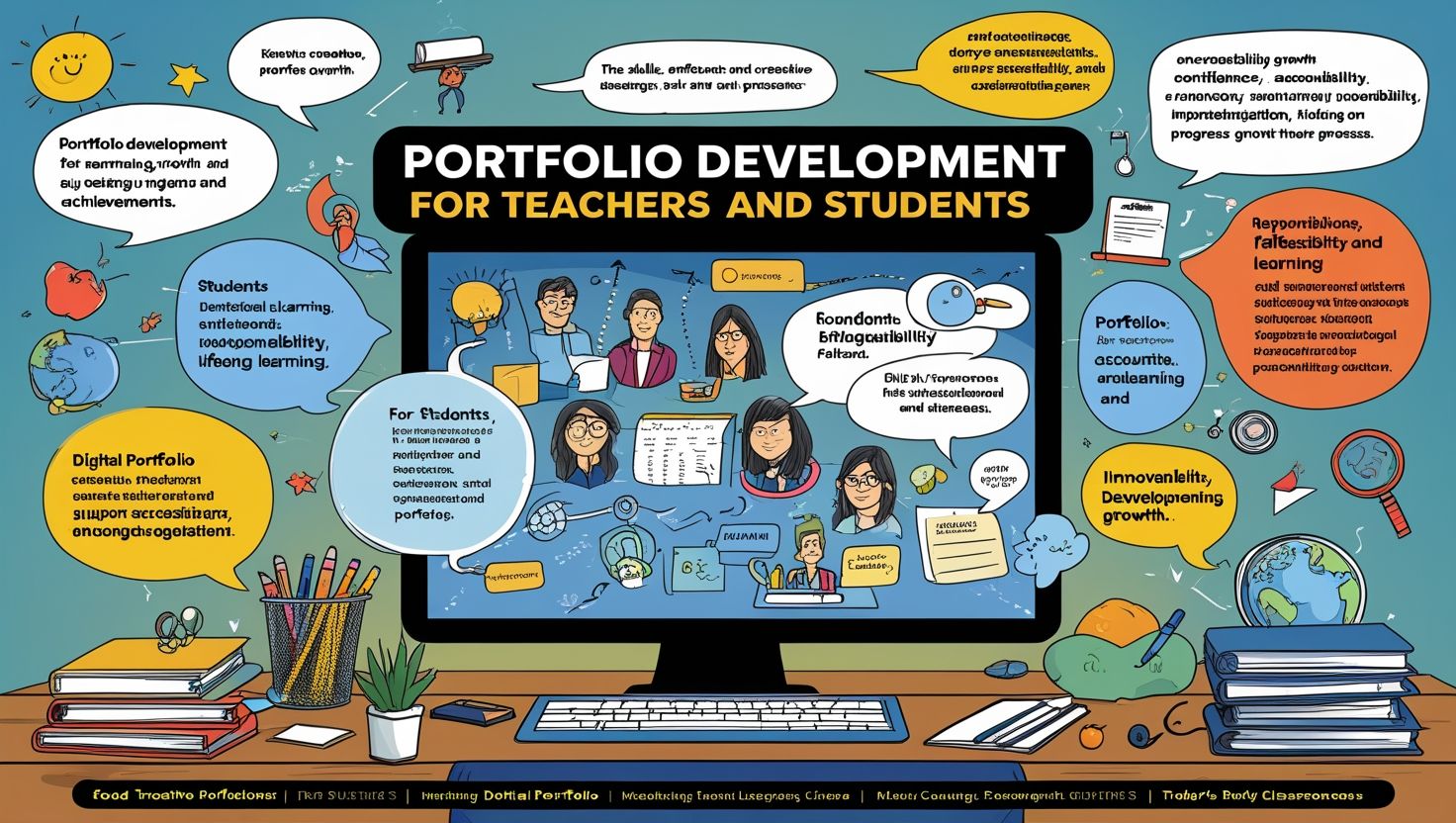Introduction
Portfolio Development for Teachers and Students, Portfolio development has become a vital part of modern education. It serves as a systematic collection of work that demonstrates growth, achievements, and abilities. For both teachers and students, portfolios reflect learning journeys, skills, and accomplishments. They are not merely folders of assignments but purposeful compilations that show evidence of progress. In education, they provide opportunities for reflection, evaluation, and improvement. Portfolios may include lesson plans, projects, assessments, creative works, and reflective notes. For teachers, they demonstrate teaching philosophy and practices, while for students, they highlight academic strengths and personal development. Moreover, portfolios encourage responsibility, ownership, and goal setting. They bridge the gap between theoretical knowledge and practical application. Since portfolios evolve over time, they help to monitor growth. Therefore, portfolio development plays an essential role in self-assessment, accountability, and professional growth. It not only showcases achievements but also serves as a learning and teaching tool that enhances educational outcomes effectively.
Purpose of Portfolio Development
The primary purpose of portfolio development is to provide a structured way to document learning and teaching experiences. For students, it becomes evidence of skills, creativity, and critical thinking. For teachers, it highlights their effectiveness, planning, and reflective practices. Portfolios also serve as a communication tool between teachers, parents, and administrators. They showcase learning achievements in a more authentic way compared to standardized tests. Another purpose is to encourage reflective thinking. Students learn to analyze their progress, identify weaknesses, and set goals. Teachers, on the other hand, evaluate teaching strategies and redesign instruction where needed. Portfolios also promote lifelong learning as they require continuous updates. Additionally, they help in professional advancement. Teachers use portfolios during appraisals, promotions, or job applications, while students benefit in admissions and scholarship opportunities. Ultimately, the purpose of portfolio development lies in assessment, reflection, accountability, and improvement. It ensures that the teaching-learning process is more personalized, engaging, and goal-oriented for everyone.
Types of Portfolios
Different types of portfolios serve specific needs in education. First, there are developmental portfolios, which track learning progress over time. They show growth by comparing earlier and recent works. Next, assessment portfolios evaluate performance against set standards. These help in grading and measuring skills. Another type is the showcase portfolio, which highlights the best works of a student or teacher. It is often used during presentations, interviews, or applications. Similarly, reflective portfolios focus on critical thinking and self-analysis. They encourage learners to reflect on their strengths, weaknesses, and improvements. Teachers use these to improve instructional strategies. There are also professional portfolios for educators, including lesson plans, classroom management strategies, and evidence of teaching effectiveness. Digital or e-portfolios are gaining popularity because they allow easy access, creativity, and multimedia integration. Each type serves a unique purpose, and the choice depends on learning goals, professional requirements, or institutional needs. Together, they enhance both teaching and learning processes significantly.
Benefits for Students
The benefits of portfolio development for students are extensive. Portfolios help them develop a sense of responsibility for their learning. They encourage ownership, as students select, organize, and reflect on their works. Moreover, portfolios improve self-assessment skills. Students learn to analyze strengths and weaknesses critically. They also gain confidence by showcasing achievements. Additionally, portfolios support creative expression. Students include essays, projects, drawings, or digital media that demonstrate learning in unique ways. Another important benefit is improved communication. Portfolios provide a medium to share progress with teachers, peers, and parents. They also assist in higher education and career preparation. Universities often require portfolios for admissions, and employers value them as proof of skills. Furthermore, portfolios encourage lifelong learning because they highlight continuous progress. Students not only improve academically but also enhance personal, creative, and social growth through portfolios. Therefore, portfolios act as mirrors of development and tools for future success.

Benefits for Teachers
Teachers also benefit significantly from portfolio development. It provides them with a structured way to reflect on teaching practices. By compiling lesson plans, classroom strategies, and student feedback, teachers identify strengths and weaknesses. This reflection encourages professional growth. Portfolios also serve as evidence during appraisals, promotions, or interviews. They highlight teaching philosophy, achievements, and innovations. Moreover, they foster accountability, as administrators can review teaching effectiveness. Portfolios also promote creativity and experimentation in instructional methods. Teachers document new strategies, evaluate outcomes, and refine their approaches. Another benefit is improved communication with students and parents. Portfolios provide clear evidence of student progress, making discussions more meaningful. Digital portfolios further enhance accessibility and innovation. Teachers also use portfolios in collaborative learning by sharing practices with peers. Ultimately, teacher portfolios strengthen professional identity, improve instructional practices, and support continuous development. They go beyond record-keeping and become instruments of self-improvement and excellence in teaching.
Steps in Developing a Portfolio
Developing a portfolio requires systematic planning. The first step is to define objectives. Teachers and students must decide what the portfolio should achieve. Next, selection of content is crucial. Students may include assignments, projects, and reflections, while teachers include lesson plans, teaching philosophies, and feedback. Organization is the third step. Materials should be arranged in a logical and coherent sequence. Reflection plays a major role in development. Both teachers and students must analyze their work, identify growth areas, and highlight strengths. Presentation is another important step. Portfolios should be visually appealing and easy to understand. Digital tools can enhance creativity through videos, graphics, and interactive elements. Finally, continuous updating ensures relevance. Portfolios are not static; they must evolve with progress. Feedback from peers, teachers, or administrators also adds value. By following clear steps—objective setting, selection, organization, reflection, presentation, and updating—effective portfolios can be developed for meaningful results.
Challenges in Portfolio Development
Although beneficial, portfolio development faces several challenges. First, it is time-consuming. Collecting, organizing, and reflecting on works requires effort from both teachers and students. Another challenge is subjectivity. Assessing portfolios may involve personal judgment, leading to inconsistent evaluations. Technical barriers also exist, especially in digital portfolios. Not all students and teachers have equal access to technology or digital skills. Furthermore, portfolios demand continuous commitment. Without regular updates, they lose relevance. Teachers also face workload pressure while balancing portfolio preparation with other responsibilities. Students may find it difficult to reflect critically or select appropriate content. Additionally, privacy and security issues arise in digital platforms. Institutions sometimes lack clear guidelines, making the process confusing. Despite these challenges, effective training, proper guidance, and technological support can overcome difficulties. Addressing these barriers ensures that portfolios remain powerful tools for assessment, reflection, and professional growth in both teaching and learning contexts.

Digital Portfolios in Modern Education
Digital portfolios, also known as e-portfolios, are transforming education today. They combine traditional portfolio benefits with technology. Students can upload essays, videos, presentations, and artwork. Teachers can share lesson plans, recorded lectures, and professional achievements. Digital portfolios are easily accessible and can be shared with parents, peers, and employers worldwide. They also encourage creativity through multimedia integration. Another advantage is sustainability, as they reduce paper usage. Digital portfolios promote collaboration as students and teachers interact online. They also support lifelong learning because they can be continuously updated. However, digital portfolios require digital literacy and internet access. Security and privacy are additional concerns. Despite these, e-portfolios have become essential in modern education due to their accessibility, creativity, and global reach. They enhance traditional learning and professional practices by connecting achievements with technology, making them powerful tools for 21st-century skills.
Portfolio as an Assessment Tool
A portfolio is a highly effective assessment tool. Unlike traditional exams, it provides a holistic view of learning and teaching. It includes projects, assignments, reflections, and creative works that demonstrate understanding. For students, portfolios show progress and achievements over time. They reflect not only results but also efforts and processes. For teachers, portfolios assess teaching strategies, classroom management, and professional growth. They offer evidence of innovation and effectiveness. Moreover, portfolios allow self-assessment. Learners reflect on strengths and weaknesses, while teachers evaluate their instructional practices. Portfolios also support formative assessment because they provide continuous feedback rather than final grades only. This makes learning more meaningful. In addition, they encourage personalized evaluation, considering individual strengths. As an assessment tool, portfolios provide a balanced, authentic, and comprehensive view of performance. They go beyond memorization and measure real skills, creativity, and reflective practices. Thus, they enhance the quality of education.
Conclusion
In conclusion, portfolio development for teachers and students is a powerful educational practice. It enhances learning, teaching, reflection, and assessment. Students gain responsibility, creativity, and confidence, while teachers develop professional identity and growth. Portfolios serve purposes of communication, accountability, and continuous improvement. Despite challenges such as time and subjectivity, portfolios remain valuable. The rise of digital portfolios has further revolutionized the process by making it more creative, accessible, and sustainable. When used effectively, portfolios provide authentic evidence of growth, promote lifelong learning, and support professional advancement. They ensure that education is not just about memorization but about skills, reflection, and progress. Therefore, portfolio development must be integrated into modern education to benefit both teachers and students meaningfully.
References
- Barrett, H. C. (2007). Researching electronic portfolios and learner engagement. Journal of Adolescent & Adult Literacy, 50(6), 436–449.
- Shulman, L. S. (1998). Teacher portfolios: A theoretical activity. New Educator, 2(1), 63–70.
- Zeichner, K., & Wray, S. (2001). The teaching portfolio in US teacher education programs. Teaching and Teacher Education, 17(5), 613–621.
- Lorenzo, G., & Ittelson, J. (2005). An overview of e-portfolios. Educause Learning Initiative.
- Paulson, F. L., Paulson, P. R., & Meyer, C. A. (1991). What makes a portfolio a portfolio? Educational Leadership, 48(5), 60–63.

Istanbul local tours The city tour was simply perfect! https://elmercadodemipueblo.es/?p=216929
Interesting read! Building a solid foundation is key, whether it’s poker strategy or learning a new platform like the jljl55 ph app casino. A structured approach, as they detail, seems smart for beginners wanting to improve their game.
s6r6ix
อ่านแล้วเข้าใจง่ายดี ที่สรุปเรื่อง
IQOS Thailand ไว้ดี เห็นภาพรวมทั้งหมดเลย เคยลองใช้แล้วประทับใจ รอติดตามอัปเดตข้อมูลใหม่ๆ นะ
บทความนี้เกี่ยวกับพวงหรีดดอกไม้
เป็นประโยชน์สุดๆ
กำลังค้นหาข้อมูลเรื่องนี้อยู่พอดี ถือว่าเจอบทความดีๆ เลย
ใครที่กำลังเตรียมตัวจัดงานศพให้คนสำคัญควรอ่านจริงๆ
My site … รับจัดดอกไม้งานศพ